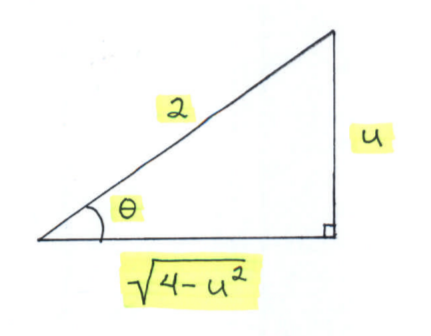SOLUTION 16: $ \ \ $ Integrate $ \displaystyle{ \int {
\sqrt{1-x} \cdot \sqrt{x+3} } \ dx } $. Begin with the power substitution.
$$ 1-x = u^{2} $$
so that
$$ x = 1-u^2 $$
and
$$ dx = -2u \ du $$
Substitute into the original problem, replacing all
forms of $ x $, getting
$$ \displaystyle { \int \sqrt{1-x} \cdot \sqrt{x+3} \ dx = \int
\sqrt{u^{2}} \cdot \sqrt{(1-u^{2})+3} \cdot (-2u) \ du} $$
$$ = \displaystyle { \int u \cdot \sqrt{4-u^{2}} \cdot (-2u) \ du} $$
$$ = -2 \displaystyle { \int u^2 \cdot \sqrt{4-u^{2}} \ du} $$
Now use the trig substitution
$$ u = 2 \sin \theta $$
so that
$$ du = 2 \cos \theta \ d \theta $$
Substitute into the original problem, replacing all
forms of $ u $, getting
$$ -2 \displaystyle { \int u^2 \cdot \sqrt{4-u^{2}} \ du}
= -2 \displaystyle { \int (2 \sin \theta)^2 \cdot \sqrt{4-4 \sin^{2}
\theta} \cdot 2 \cos \theta \ d \theta } $$
$$ = -4 \displaystyle { \int 4 \sin^2 \theta \cdot \sqrt{4 (1- \sin^{2}
\theta ) } \cdot \cos \theta \ d \theta } $$
$$ = -16 \displaystyle { \int \sin^2 \theta \cdot 2 \sqrt{\cos^{2}
\theta} \cdot \cos \theta \ d \theta } $$
$$ = -32 \displaystyle { \int \sin^2 \theta \cdot \cos \theta
\cdot \cos \theta \ d \theta } $$
$$ = -32 \displaystyle { \int \sin^2 \theta \cos^2 \theta \ d \theta } $$
$$ = -32 \displaystyle { \int (\sin \theta \cos \theta)^2 \ d \theta } $$
(Recall that $ \sin 2 \theta = 2 \sin \theta \cos \theta $ so that
$ \sin \theta \cos \theta = \displaystyle{ \frac {1}{2} } \sin 2 \theta $ .)
$$ = -32 \displaystyle { \int \Big(\frac {1}{2} \sin 2 \theta \Big)^2 \ d \theta } $$
$$ = -32 \displaystyle { \int \frac {1}{4} \sin^2 2 \theta \ d \theta } $$
(Recall that $ \cos 2 \beta = 1 - 2 \sin^2 \beta $ so that
$ \sin^2 \beta = \displaystyle{ \frac {1}{2} } (1-\cos 2 \beta) $ .)
$$ = -8 \displaystyle { \int { \frac {1}{2} } (1-\cos 2 (2 \theta )) \ d \theta } $$
$$ = -4 \displaystyle { \int (1-\cos 4 \theta ) \ d \theta } $$
$$ = \displaystyle { -4 \Big( \theta - \frac {1}{4 } \sin 4 \theta \Big) + C } $$
$$ = \displaystyle { -4 \theta + \sin 4 \theta + C } $$
(Recall that $ \sin 2 \beta = 2 \sin \beta \cos \beta $ .)
$$ = \displaystyle { -4 \theta + \sin 2(2 \theta) + C } $$
$$ = \displaystyle { -4 \theta + 2 (\sin 2 \theta )( \cos 2 \theta ) + C } $$
(Recall that $ \cos 2 \theta = \cos^2 \theta - \sin^2 \theta $ .)
$$ = \displaystyle { -4 \theta + 2 ( 2 \sin \theta \cos \theta )(\cos^2 \theta - \sin^2 \theta ) + C } $$
$$ = \displaystyle { -4 \theta + 4 \sin \theta \cos^3 \theta - 4 \sin^3 \theta \cos \theta + C } $$
$\Big($ We need to write our final answer in terms of $x$.

Since
$$ u = 2 \sin \theta $$
it follows that
$$ \sin \theta = \frac{ u }{ 2 } = \displaystyle{ opposite \over hypotenuse } $$
and
$$ \theta = \arctan \frac{u}{2} $$
and from the Pythagorean Theorem that
$$ (adjacent)^2 + (opposite)^2 = (hypotenuse)^2 \ \ \longrightarrow $$
$$ (adjacent)^2 + (u)^2 = (2)^2 \ \ \longrightarrow \ \ \ adjacent = \sqrt{4-u^2} \ \ \longrightarrow $$
$$ \cos \theta = \displaystyle{ adjacent \over hypotenuse}
= \frac{ \sqrt{4- u^2} }{ 2 } . \Bigg) $$
$$ = \displaystyle { -4 \arctan \frac{u}{2} + 4 \frac{ u }{ 2 } \Bigg( \frac{ \sqrt{4- u^2} }{ 2 } \Bigg)^3 - 4 \Bigg( \frac{ u }{ 2 } \Bigg)^3 \frac{ \sqrt{4- u^2} }{ 2 } + C } $$
(Now use the fact that $ u^2=1-x $ and $ u= \sqrt{1-x} $.)
$$ = \displaystyle { -4 \arctan \frac{\sqrt{1-x} }{2} + 4 \frac{ \sqrt{1-x} }{ 2 } \Bigg( \frac{ \sqrt{4- (1-x )} }{ 2 } \Bigg)^3 - 4 \Bigg( \frac{ \sqrt{1-x} }{ 2 } \Bigg)^3 \frac{ \sqrt{4- (1-x )} }{ 2 } + C } $$
$$ = \displaystyle { -4 \arctan \frac{\sqrt{1-x} }{2} + \frac{1}{4} \sqrt{1-x}(x+3)^{3/2}
- \frac{1}{4} (1-x)^{3/2} \sqrt{x+3} + C } $$
Click HERE to return to the list of problems.

